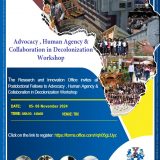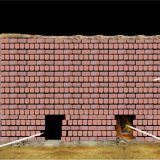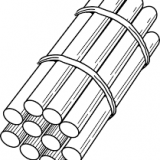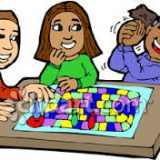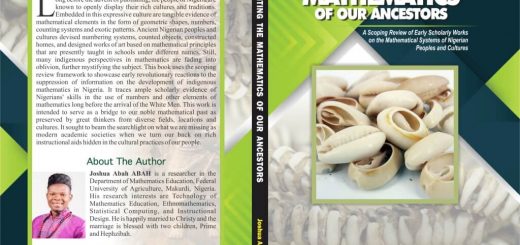Indigenous Burnt Bricks Production in the Benue Valley
![]()

Africa has always pride herself as a cradle of rich indigenous knowledge systems. This richness is seen in the daily practices of ordinary people; in their culture, agriculture, architecture and religion. The signature of advanced scientific thinking can be found across several distinct cultural artefacts and socio-economic structures of ordinary people. Ranging from the knitted grass huts of the nomadic Fulanis to the mud houses of the Benue Valley civilization, there can be seen distinct manifestation of mathematical knowledge in the form of geometric patterns, solid shapes and meaningful use of numbers.
Among the numerous indigenous mathematical feats of the people of the Benue Valley, the one which stood out the most is the measured process of making burnt bricks, the ubiquitous building blocks for diverse local constructions works in the region. The Benue River is the longest tributary of the Niger (about 650 mile). It rises in the Adamawa Plateau of Northern Cameroon, from where it flows west, and through the town of Garoua and Ladgo Reservoir, into Nigeria south of the Mandara mountains and through Makurdi before meeting the Niger River at Lokoja. The floodplain soils occupy about 1,179,400 hectares along the river Benue and are useful for agricultural production and construction works.
The Making of Burnt Bricks
The use of bricks in building and construction in the Benue Valley pre-dates the colonial era. From early times, dwellers along the Benue valley trough construct their round huts by moulding the walls with sticky clay mud. In this style of building, chunks of clay mud are packed upon each other and moulded upwards with hands without any noticeable joints or plastering. Still, weak fissures existing between the layers or chunks of clay mud becomes visible cracks as the wall ages. These cracks may result in total collapse of large portions of the moulded wall, particularly during the long rainy season.
A way of minimizing wall collapse due to mud fissures is to first mould units of mud blocks which are allowed to get dry and strong before being used in the building of walls. The strong blocks, dried in the sun are then placed upon each other and held together by mortar made of viscous clay mud. This second approach extended the life span of the wall of buildings. However, very damp conditions around the wall can still soften both block and joint materials, resulting in partial or total collapse of the building. This existential problem with normal mud blocks necessitated the burning of mud blocks to further strengthen building to withstand adverse wet conditions.

Clay bricks are man-made materials that are widely used in building, civil engineering work, and landscape design. One of the legacies of the colonial government in Africa was the scattered pieces of colonial and government flats built with clay bricks dotted within the countries especially along the coastal areas (Baiden, Agyekum, & Oferi-Kuragu, 2014). Although the practice of burnt clay brick manufacturing was modernized by the missionaries who continued to produce bricks and tiles even after the Second World War, it is the in-expensive indigenous clay bricks burning of the people that persisted into modern times. Certain properties of these burnt bricks makes them desirable for local building construction works.
Baiden et al. (2014) provides in-depth details on the properties of burnt bricks. Generally, a good brick must be hard, well burnt, uniform throughout, sound in texture and colour, sharp in shape and dimension, and should not easily break when stuck against another brick or dropped form a height of about one metre. Among the desirable properties of burnt clay bricks are compressive strength, density, thermal stability, porosity, sound insulation, fire resistance, durability, and water resistance (Baiden et al., 2014).
The following steps are involved in Burnt Bricks Production:
Step 1: A wooden mould, with inner dimensions being 10 inches long, 5 inches wide and 5 inches high, has to be constructed from strong plane planks. It is firmly knotted or nailed with a two small handles attached to the side.
Step 2:Clear and level the ground where the bricks are to be laid.
Step 3: Dig a heap of soil. The size of the heap depends on the number of blocks to be produced. For higher number of blocks, the heaps may have to be dug out in different places.
Step 4: Wet the heaped soil to soften it. The soil is then mixed by turning with a hoe and pressing it with the feet. This stirring is repeated until the mud is sticky and viscous. The lump of wet clay mud is then left for at least 12 hours. When this is done, the clay mud becomes ready for the laying of bricks.
Step 5: Now the actual laying of bricks is carried out as follows, on the smooth ground prepared in step 2 above.
- The rectangular wooden mould is dipped (not soaked) in water so that it will not stick to its intended content. This wetting is also required to obtain very smooth bricks.
- Fill up the wooden mould with the mud and press it firmly with the hand.
- Draw out the mould by lifting the handle. This is done slowly, carefully and gently to leave behind a firm block of mud.
Step 6: Repeat step 5 until the heap of wet clay mud is exhausted.
Step 7: Cover the laid bricks with grasses to prevent them from cracking. Allow the covering to stay for 3 to 5 days.
Step 8: Remove the covered grasses and allow the bricks to dry up in the sun.
Step 9: Packing and arrangement for baking: This process requires bringing the dry bricks together and arranging them systematically. The arrangement is done such that two tunnels measuring 3 feet wide and 4 feet high is formed across the width of the packed blocks. The tunnels are to be big enough for firewood to fit in.
Step 10: The tunnels are then loaded with logs of fresh firewood. This is done while the arrangement of bricks in still half-complete. It is not advisable to crawl into the tunnel with bricks packed up on it; this is to avoid accidents that may result from the collapse of the bricks. So, the logs of wood are loaded into the tunnel before the arrangement of bricks on top is completed.
Step 11: To prevent heat loss, cover the spaces around the arranged bricks with mud. In other words, the four sides and top of the arranged blocks are plastered with thick mud. The top of the bricks is also covered with grasses. This makes the entire set-up a kind of a kiln.
Step 12: Put fire to the loaded firewood in the two tunnel and allow the kiln to bake the blocks.
Step 13: Keep the fire burning until the grasses at the top of the arranged bricks get burnt.
Step 14: Close the holes (all entrances to the tunnel) with mud and leave the burning kiln until the day it finally cools. This internal baking may take between 3 to 7 days.
Step 15: The assessment of whether the burnt bricks are strong or not is carried out by putting one of the burnt bricks inside water for at least 5 days, or trying to break one up.
At the end of these steps, the burnt bricks are considered suitable for building and other civil engineering works. In the Benue Valley region, this hard bricks are the preferable choice for constructing foundations of building in water-logged areas. It is thus common to see residential houses, churches, mosques, and parking lots built entirely from burnt bricks.
It is noteworthy that the type of soil considered most suitable making burnt bricks is clay soil. The production of bricks is not advisable during wet/rainy season for the obvious reasons. Also, logs from hard trees that do not burn away quickly are considered most suitable for heating the bricks.
Specific Instances of Mathematics in Burnt Bricks Production
Here are some specific instances of mathematics in the steps involved in burnt bricks production.
Plane and Solid Shapes: The wooden mould used for the making of the blocks in rectangular in shape.
Cost Estimation: The cost of the materials used in making the rectangular mould can be estimated if the thickness of the wood is known. Similarly, the cost of water, firewood and other resources needed for the production of burnt bricks can be estimated along with the number of bricks to be produced. Profit or loss can thus be evaluated if the price of one unit of burnt brick is known.
Volume: The heap of clay soil for the production is usually left as a huge cone. The volume of this cone can be calculated and then related to the quantity of bricks that can be produced from the heaped volume of soil. Other mensuration components can be innovatively extracted by the mathematics teacher to enrich classroom work.
Numbers and Numeration: The business of burnt bricks production is an enterprise of numbers. The arrangement of the bricks to make a heating kiln is a rich lesson in counting. Considering the number of blocks in a typical kiln, the mathematics teacher may ask students to reason out how many of such kilns will be required to bake certain number of bricks, making necessary adjustments for defects. The number of blocks estimated for projects can also be easily worked out and even related to other raw materials used in the production.
Everyday Statistics: Lessons on record keeping can also be designed around burnt bricks production. The value chain in the business of burnt bricks production includes workers who serves as loaders of the finished products, Lorries and trucks that convey the goods from the production sites to project sites, women who fetch water from nearby streams for the production, etc. All these workers earn their living from the profits made after the sales of the bricks. Lessons in statistics may link the number of bricks corresponding to the units of inputs from each category of workers. Classroom examples and field trips can be planned by the ingenuous mathematics teacher to further enrich mathematics instruction, particularly at the Basic Education Level.
Conclusion
One of the ways the peoples of the Benue Valley derive economic gain form the natural resources of the region is the local production of burnt bricks. The craft of burnt bricks making has been passed down from one generation to the other among the numerous indigenous communities of the region. This explorative study has examined the mathematics embedded in this cultural practice. Attention has been drawn to the need to incorporate elements of mathematics found in the student’s immediate socio-cultural environment into classroom activities to reduce the perceived abstractness of the subject.
References
Abah, J. A. (2016). Recency bias in the era of big data: The need to strengthen the status of history of mathematics in Nigerian schools. Advances in Multidisciplinary Research Journal, 2(4), 241-248. A Publication of the International Centre for Information Technology & Development, Southern University, Baton Rouge, LA, USA. Retrieved on 15th December, 2017 from http://media.wix.com/ugd/185b0a_9b1253273fea46768d1d96dcd03f4887.pdf
Abah, J. A. (2017). Viewing basic math through the lens of history: Undergraduates’ reflective learning in a history-augmented mathematics classroom. Waikato Journal of Education, 22(4), 33-48. doi:10.15663/wje.v22i4.557 . A publication of Wilf Malcolm Institute of Educational Research, The University of Waikato, New Zealand. Retrieved on 2nd March, 2018 from http://www.wje.org.nz/index.php/WJE/article/view/557
Abah, J. A. (2018). A mathematical portrayal of a Christmas carol for Nigerian basic education: The mathematics in the twelve days of Christmas. Indian Journal of Arts, 8, 43-57. A publication of The Discovery Scientific Society. Retrieved on 17th April, 2018 from http://www.discoveryjournals.org/arts/current_issue/2018/A4.pdf
Abah, J. A., Iji, C. O. & Abakpa, B. O. (2018). Blown Away in the Wind of Change: Can Extinct School Folktales be awakened through Mathematics Storytelling in Nigerian Basic Education? International Journal on Emerging Mathematics Education (IJEME), 2(2), 165-178. [Available from: http://journal.uad.ac.id/index.php/IJEME/article/download/10561/pdf_28 ]
Abakpa, B. O., Abah, J. A. & Agbo-Egwu, A. O. (2018). Science Curiosity as a Correlate of Academic Performance in Mathematics Education: Insights from Nigerian Higher Education. African Journal of Teacher Education (AJOTE), 7(1), 36-52. DOI: 10.21083/ajote.v7i1.3904 A publication of SPREAD Corporation (Sustainable Programs for Reducing Educational and Avocational Disadvantages), University of Guelph, Canada. Retrieved on 23rd April, 2018 from https://journal.lib.uoguelph.ca/index.php/ajote/article/download/3904/4139
Baiden, B. K., Agyekum, K. & Oferi-Kuragu, J. K. (2014). Perceptions on barriers to the use of burnt clay bricks for housing construction. Journal of Construction Engineering, 2014, Article ID: 502961. DOI: http://doi.org/10.1155/2014/502961
Barton, B. (1992). A philosophical justification for ethnomathematics and some implications for education. Proceedings of Conference of the Mathematics Education Research Group of Australasia, held at Hawkaid Conference Centre, University of Western Sydney, 4-8 July, 1992. Pp 102-111.
Brandt, A. & Chernoff, E. J. (2014). The importance of ethnomathematics in the math class. Ohio Journal of School Mathematics, Fall 2014 (71), 31-36.
D’Ambrosio, U. (1990). Ethnomathematics: The art or technique of explaining and knowing. ISGEm. Sao Paulo, Brazil: Editora Atica.
D’Ambrosio, U. (1992). The history of mathematics and ethnomathematics: How a native culture intervenes in the process of learning science. Impact of Science on Society, 40(4), 369-378.
D’Ambrosio, U. (1994). Cultural framing of mathematics teaching and learning. In R. Biehler, R. W. Scholz, R. Straber & B. Winkelmann (Eds.), Didactics of Mathematics as a Scientific Discipline, 443-455.
D’Ambrosio, U. (2001). Ethnomathematics: A link between traditions and modernity. Sao Paulo, Brazil: Editora Autentica.
Francois, K. & Van Kerkhove, B. (2010). Ethnomathematics and the philosophy of mathematics (education). In B. Lowe & T. Muller (Eds.), PhiMSAMP. Philosophy of Mathematics: Sociological Aspects and Mathematical Practice. London: College Publications. pp 121-154.
Francois,K. & Pinxten, R. (2013). Multimathemacy. Proceedings of the Eight Congress of the European Society for Research in Mathematics Education (CERME 8). pp 1735-1743.
Freudenthal, H. (1973). Mathematics as an educational task. Dordrecht: Reidel Publishing.
Furuto, L. H. L. (2014). Pacific ethnomathematics: Pedagogy and practices in mathematics education. Teaching Mathematics and its Applications. pp 1-12. DOI: 10.1093/teamat/hru009
Gerdes, P. (1996). On the ethnomathematics and the transmission of mathematical knowledge in and outside schools in Africa south of the Sahara. In M. Barrere (Ed.), 20th Century Sciences: Beyond the Metropolis, Vol. 5: Sciences and Development, pp 229-246.
Lakoff, G. & Nunez, R. (2000). Where mathematics comes from: How the embodied mind brings mathematics into being. New York: Basic Books.
Orey, D. C. & Rosa, M. (2006). Ethnomathematics: Cultural assertions and challenges towards pedagogical action. The Journal of Mathematics and Culture, 1(1), 57-78.
Zaslavsky, C. (1994). “Africa Counts” and Ethnomathematics. For The Learning of Mathematics, 14(2), 1-8. Zhang, W. & Zhang, Q. (2010). Ethnomathematics and its integration within the mathematics curriculum. Journal of Mathematics Education, 3(1), 151-157.
Views: 1294

